For any rooftop solar system, making sure all the components of the solar mounting and racking system are compatible with the roof is of high importance — issues such as weight of ballast blocks on commercial roofs, the fire resistance of plastic components or chemical reactions between components and roof membrane. A particularly important and lesser known issue, pointed out to us by Sara Carbone and Roland Jasmin at SunModo, is EPDM’s chemical incompatibility with asphalt shingles, which can result in serious roof damage and premature roof failure.
EPDM issue
EPDM (ethylene propylene diene monomer) is a popular synthetic rubber across industries due to its low cost, durability and moldability. A good number of roof attachments in the solar racking industry use EPDM gaskets to create a watertight seal around the roof penetration. These gaskets are traditionally separated from roof shingles with metal flashing, but there are a number of new roof attachments that have cut out the flashing in order to offer cost savings and easier installation. This is problematic because EPDM is not compatible with bitumen, or petroleum-based, products and asphalt shingles are practically solid sheets of petroleum.
Due to their low cost, ease of install and availability in dozens of colors, asphalt shingles are the most popular choice for residential roof coverings and many commercial buildings. Unfortunately, contact between asphalt shingles and EPDM causes a chemical reaction in which the EPDM gasket degrades, becomes brittle and eat into the shingles, something studies on the molecular interaction of rubber with asphalt have confirmed. As a result, EPDM gaskets should never come in contact with asphalt shingles.
A compatible solution
In these non-flashing situations, SunModo recommends silicone rubber as a substitute for EPDM rubber. It has material properties that make it ideal for outdoor applications, and silicone coatings are often applied to roofs to provide a layer of protection that helps extend the life of the roof. Silicone rubber is compatible with concrete, TPO, PVC, EPDM roof coverings and, of course, asphalt shingles.
While it is important that designers, engineers and contractors strive to save money when working on rooftop solar projects, they should do so in a way that does not compromise the integrity of the roof.
— Solar Builder magazine

Leave a Reply
You must be logged in to post a comment.